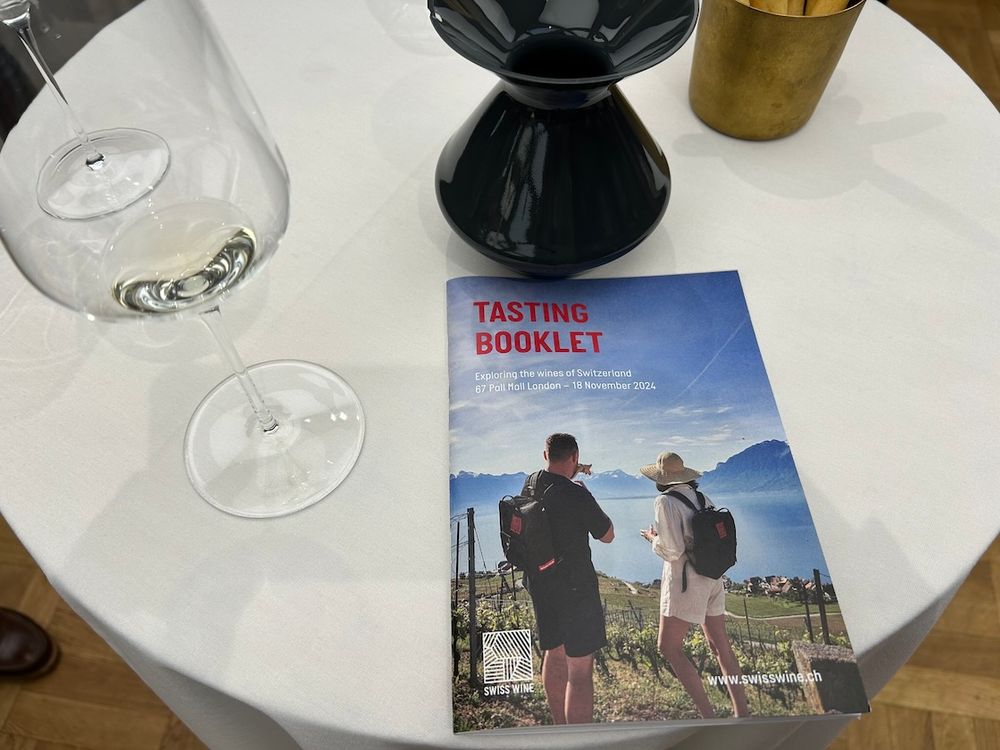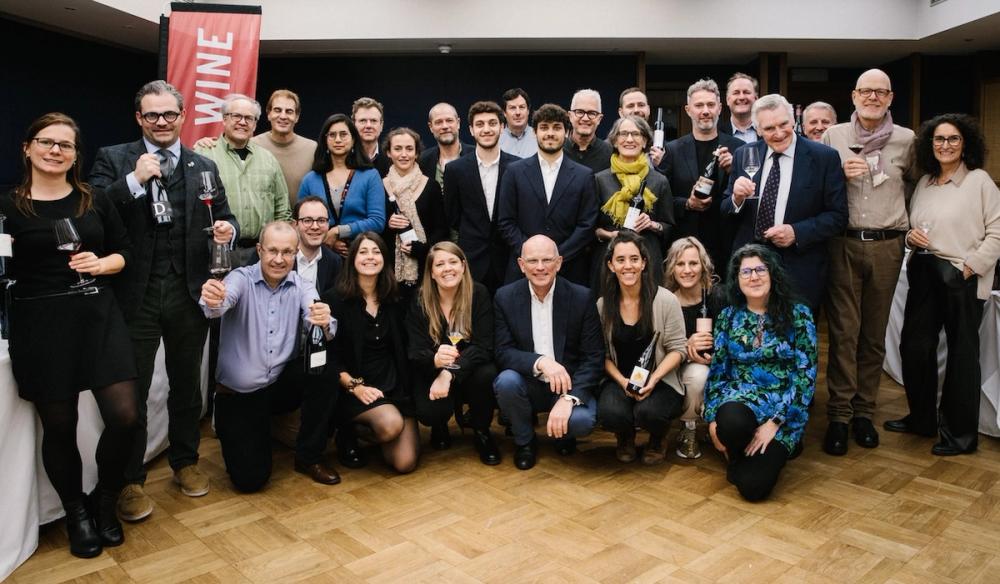Swiss Wine Week was upon us. When I first considered Switzerland as a wine-producing country many years ago, I was slightly puzzled. Where do I start? What wines do they grow? Then I met Joelle Nebbe-Mornod from Alpine Wines at the London Wine Fair in 2015. "Right here," she said. "Come and try our Chasselas!" So there was the first connection.
My grandfather used to grow Chasselas during the 1930s in Hungary, where it was favoured for its high alcohol content – funny how times change. However, winemakers then under-appreciated this grape, and it was almost entirely grubbed out. I still remember first tasting this variety over a decade ago, and what appealed to me back at the London Wine Fair was the quality. The wine had a fresh nose, almost homogeneously so, with white flowers enticing with their delicate tease that draws onto a slightly oily palate. Then, an explosion of lemon and vibrant minerality, followed by layers of saltiness. What a delightful wine!
Swiss Wine Promotion: Swiss Wine Week and beyond

The tasting I attended was part of Swiss Wine Week, a new initiative launched by Swiss Wine Promotion (SWP) in November 2024. Designed to introduce Swiss wines to a broader international audience, the programme included tastings, masterclasses, and retailer collaborations across key markets, including London.
Switzerland's wine industry is both small and distinctive. The country produces just over 979,000 hectolitres of wine annually, with approximately 14,696 hectares under vine. Despite its modest size, Switzerland grows an impressive 252 grape varieties across six key wine regions, with 168 officially accepted under cantonal AOC regulations. Red and white wine production is nearly equal, and the focus on artisanal quality is evident in every bottle.
Domestic consumption is strong, with Swiss residents drinking an average of 33 litres of wine per capita each year, leaving less than 2% for export. Key export markets include Germany, France, and the USA. The low export rate makes tastings like Swiss Wine Week essential to raising the profile of Swiss wines internationally.
As Simon Hardy DipWSET explained, "Swiss Wine Week is a new concept being rolled out by Swiss Wine Promotion in key export markets... It is designed to introduce Swiss wine to an international audience and promote its quality and diversity, while creating unique experiences for wine lovers."
The 6 wine regions of Switzerland

Assembled throng: the importers and producers who held the Swiss wine tasting in London
Switzerland’s six wine regions are as diverse as its landscapes, languages, and traditions. From the sun-drenched vineyards of Valais in the Alps to the Mediterranean-influenced slopes of Ticino, each region has an unique identity shaped by geography and culture.
1 – Valais
(32% of production)
Switzerland’s largest wine region, Valais, sits in the Rhône Valley in the heart of the Alps. The dry, sunny climate – 2,500 hours of sunshine annually – and glacial soils create ideal conditions for a variety of grapes. Indigenous varieties like Cornalin and Petite Arvine shine alongside international ones like Syrah.
Highlights:
Domaine Jean-René Germanier, Vétroz
Established in 1896 by Urbain Germanier in Vétroz, this is a distinguished Swiss winery with a rich heritage. Over four generations, the estate has evolved, led by Jean-René Germanier and his nephew, Gilles Besse, both trained oenologists. Over 60 hectares and around 1 million bottle production.
Fendant Vétroz Les Terrasses 2023
Classic Chasselas, showcasing firm mineral grip, wet stone notes, and a clean, refreshing finish.
Cayas Syrah du Valais Réserve 2021
This Syrah is all about cool-climate elegance. Peppery and smoky with fine tannins and excellent length.
UK importer: Alpine Wines

The Alpine Wines stand at the London tasting
Les Celliers de Vétroz is a family-owned winery located in Vétroz, Switzerland, within the Valais region. Founded by their parents, the estate is now managed by five siblings, each contributing their unique expertise to the operation. The vineyard spans 5 hectares on the steep, terraced slopes of Vétroz, planted at altitudes between 520 and 670 meters above sea level. The soils are composed of marl and limestone, providing a favourable environment for cultivating a variety of grape types.
Petit Arvine 2022: A delicate balance of white flowers and tropical fruits like lychee and tangerine. The zippy finish is irresistible.
Syrah 2021: Elegant with notes of redcurrant, pepper, and subtle smoke from barrique agieng.
UK Importer: Origin Wine
Domaine des Muses, Sierre

Helmed by Robert Taramarcaz, who took over the family winery in 2002. He trained in Burgundy, with a Master’s degree in oenology from Dijon, Robert brings extensive expertise and passion to the craft. His innovative approach has earned numerous awards in Switzerland, and his wines reflect the diversity and potential of the Valais terroir.
The vineyards benefit from the driest climate in Switzerland, with the Rhône providing morning fog and the warm Foehn winds creating an ideal environment for grape maturation. Despite its alpine location, the region is perfectly suited for cultivating a wide range of varieties, from Cornalin to Petite Arvine or international ones like Syrah and Marsanne.
Cornalin Tradition 2022: A medium-bodied gem with violets, cranberries, and raspberries that evolve into earthy blackcurrant tones. Beautifully balanced and highly drinkable.
UK Importers: Gauntleys of Nottingham and Alpine Wines.
Le Vin de l’A, Ollon

Le Vin de l’A began in 2018 with Alex Stauffer’s purchase of a small 500 m² Pinot Noir plot in Flanthey. Now a 4-hectare estate with sites in Ollon, Valençon, Sierre, and Chalais, it cultivates 13 grape varieties with very low yields of 20-40 hl/ha. Its steep, sandy, and limestone slopes (600-700 meters above sea level) are worked organically, guided by lunar rhythms, and fortified with biodynamic plant-based preparations. Since 2023, the estate has been transitioning to full organic certification.
Chasselas de l’A 2023: A saline tang, bright minerality, and a grippy texture define this standout Chasselas.
L’Aristocrate 2022 (Pinot Noir): Pepper, graphite, and crunchy acidity combine with supple tannins for a wine of both charm and ageing potential.
Le Vin des Amants 2022 (Cornalin): Packed with cherry, blackberry, and soy sauce notes, this structured red has youthful energy and a promise to age beautifully.
Alex Stauffer describes winemaking as "a long path to discovery and temptation." His wines are authentic and atypical, reflecting the diversity and complexity of Valais terroir.
(Looking for an importer, these wines are worth every penny!)
2 - Vaud
(26% of production)
Stretching from Lake Geneva to Lake Neuchâtel, Vaud’s vineyards benefit from the moderating effects of these large bodies of water, which regulate temperatures and reduce frost risk. The region is dominated by Chasselas, which makes up 60% of plantings.
Highlights:
Domaine Henri Cruchon, Echichens

Located in Echichens, near Lake Geneva in Vaud, Domaine Henri Cruchon is a family-run estate that has become a key name in the region. 42 hectares spread over 112 vineyard plots, the estate is managed with a focus on organic and biodynamic principles. The work has an emphasis on expressing the nuances of terroir, particularly through their use of Chasselas. Wines are made with indigenous yeasts and minimal intervention.
Omnis Orange Nature 2023
A fun blend of Gewürztraminer, Altesse, and Sauvignon Blanc, this unfiltered orange wine is aromatic, textured, and endlessly intriguing.
UK importer: Alpine Wines
Luc Massy, Lavaux
Lavaux, a UNESCO World Heritage site, is renowned for its terraced vineyards, particularly in the steep Dézaley sub-region, which many consider the pinnacle of Chasselas terroir. The slope is so extreme that vineyard work often requires labour on hands and knees – a testament to the dedication required to cultivate here. Among Dézaley's most famous sites is Chemin de Fer, named after the trainline that cut through a small section of the vineyard. Massy’s grandfather ensured the remaining land was meticulously replanted, preserving its legacy.
Dézaley Grand Cru Chemin de Fer 2022
Rip, pink lady apple, and a slight tropical note. Incredibly round palate and depth with a slightly buttery palate thanks to malo. Satisfying sealine finish.
UK importer: Alpine Wines
3 – German speaking Switzerland
(18% of wine production)
This region includes Zurich, Basel, and Graubünden. Vineyards are typically near rivers and lakes, benefiting from cooler climates. Pinot Noir dominates the red plantings, while Räuschling, (an ancient white grape prized for its frost hardiness, closely related to Riesling), thrives in Zurich).
Highlights:
Bechtel Weine, Zurich
Located in Eglisau along the Rhine in German-speaking Switzerland, Bechtel-Weine focuses on producing wines that reflect the region’s terroir and Grand Cru status. Managed by Mathias Bechtel since 2008, the estate cultivates a variety of grapes, including Pinot Noir, Chardonnay, and the traditional Räuschling. The winery emphasises sustainable practices and careful handling of the grapes to preserve their natural character.
Räuschling 2018
Floral with petrol and honeyed nuances, this wine has vibrant acidity and focused minerality – unique, and rarely found outside Switzerland.
UK Importer: Alpine Wines
4 – Geneva
(9% of Production)
Situated around Lake Garda and near the Jura mountains, Geneva was the first canton to establish the AOC system in Switzerland. The region is known for a variety of wine styles, from light and fruity whites to structured reds, catering to a cosmopolitan market.
5 – Ticino
(8% of Production)
Situated on the southern slopes of the Alps, near the Italian boarder Ticino’s Mediterranean climate makes it ideal for Merlot, which accounts for over 80% of its plantings.
Notable producer Gialdi Vini, founded in 1953 collaborates with over 200 small growers to make terroir-driven wines. The region also offers Merlot Bianco, a white wine made from red grapes by gently pressing to avoid skin contact, resulting in a pale wine with fresh acidity, floral aromas, and flavours of stone fruit and citrus.
6 – Three Lakes
(7% of Production)
This region encompasses vineyards along Lakes Neuchâtel, Biel, and Morat. The lakes moderate the climate, making it ideal for Pinot Noir, Chasselas, and Chardonnay. Sparkling wines are also notable here.
In summary...
Switzerland’s wine industry, though modest in scale, represents quality and diversity. From the saline Chasselas of Vaud to the structured Cornalin of Valais, each region offers a distinctive expression of its terroir. Swiss Wine Week has provided a valuable platform for showcasing these creative and engaging wines to an international audience.
As Simon Hardy noted, "Swiss wines are proving that while they may be small in production, they are mighty in character." Switzerland is ready to carve its niche on the global wine stage, one bottle at a time.
































